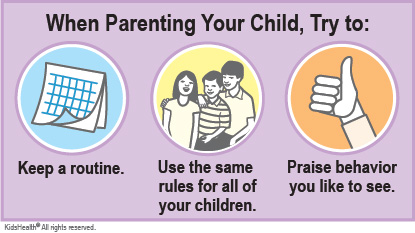Setting Limits for Your Child With a Chronic Illness
Children with a chronic illness may need more time and attention than other kids. But as with kids who aren't dealing with an illness, parents need to let them know what behaviors are expected. This is called setting limits. Parents may worry that this will be more stress for their child. But when done in a kind way, it shows kids that they are loved and cared for. Follow these tips to help your child learn which behaviors are OK and which are not.


For kids of any age:
-
Try to stick to the same daily and weekly routines, when possible. Routines help kids know what to expect.
-
Be clear about the household rules and what will happen if the rules are broken.
-
Use the same rules for all your children, when possible.
-
Make sure you notice when your child is behaving well. You could say, "I like that you gave your brother a turn with the toy."
-
Teach your child that actions have consequences (results). Here are some examples:
-
If you break a toy, the toy won't work anymore.
-
If you don't return something you borrowed, you can't borrow it next time.
-
Model the behavior you want to see. For example, a child who sees you put your own things away is more likely to pick up his or her toys.
-
Do not spank, hit, or slap your child.
For toddlers:
-
If your toddler misbehaves, calmly say: "No." Then remove your child from the area or distract him or her with another activity.
-
A time-out can help if your child continues the unwanted behavior or is hitting or biting. To do a time-out:
-
Say in just a few words why the behavior is not OK.
-
Bring your child to a "time-out place," such as a child-safe kitchen chair.
-
Have your child sit there until he or she is calm and quiet. This may take only 20 seconds or so, but it should not last longer than a few minutes.
-
When the time-out is over, welcome your child back without being angry.
For middle school kids:
-
Continue to be clear about rules, including media use.
-
Use consequences that are appropriate for this age group. For example:
-
If your son doesn't put his bike away, he doesn't get to ride it the next day.
-
If your daughter is watching videos on her phone when she is supposed to be doing homework, the phone gets put away until the next day.
For teens:
-
Give clear rules about media use, use of a car, dating, and curfews.
-
Increase your teen's responsibility and control as he or she matures. For example, you could let your teen make decisions about hair styles and clothes.
-
Give your teen more privileges as he or she shows increasing independence and responsibility.
-
If your teen does break a rule, talk about why the rule is important and, if necessary, remove a privilege (such as use of the car or cell phone).
